



Furtherfield are looking for curators for collaboration in a short-term project based at their Gallery in London’s Finsbury Park
Connect for Creativity is an 18-month project led by the British Council, in partnership with Abdullah Gül University in Turkey and three creative hubs – ATÖLYE in Turkey, BİOS in Greece, Nova Iskra in Serbia. The project is co-funded by the European Union and the Republic of Turkey, through the Intercultural Dialogue programme.
The project features art and technology residencies which will bring artists, creatives and technologists from Turkey, the UK, Greece and Serbia together at each location to explore uses of creative technology to build bridges and empathy within and across societies.
“The residencies will result in immersive and multimedia-rich artwork, powered by techniques of design research, human-centered design and speculative design. The artists will be asked to question what hopes and fears are associated with rapidly changing work and life environments in contemporary society, how a networked culture can develop cohesion and how to deal with uncertainty and change.”
To work for a maximum of 6 days each, between 1st November 2019 and 28th February 2020 at €200 per day. Must be available to attend event at Furtherfield Commons between 5.00 and 9.00pm on 6th November.
If you are a curator with Turkish, Greek or Serbian heritage born or based in London we would love to hear from you. To apply please send a 1 page CV and 1 page covering letter explaining why the project interests you to info@furtherfield.org by 12.00pm Friday 18th October. Final candidates will be notified by Friday 25th October.
Creativeworks London PhD in Residence at Furtherfield
Download a pdf of the research here
Furtherfield believe that through creative and critical engagement with practices in art and technology people are inspired and enabled to become active co-creators of their cultures and societies.
VisitorsStudio, first developed in 2003 with artist programmer Neil Jenkins, is multi-media co-creation software which aims to work towards Furtherfield’s wider goals by providing a site for real-time collaborative creation, dialogue, polemic and networked performance and play.
A new 3 month residency project at Furtherfield in partnership with Creativeworks London has invited Alex Reynolds, an AHRC funded PhD student from Kingston University, to help conceptually redesign VisitorsStudio according to contemporary developments in software and changes in social interaction and exchange associated with ubiquitous mobile technologies; and to inform the rebuild of the site as a Free and Open Source project.
The project, entitled ‘Reviewing and Open-Sourcing VisitorsStudio’ will principally involve analysing other projects similar to VisitorsStudio and consulting with its users to help identify new features for design and interaction which could help productively rethink the online creation space. The project will also mean considering ways VisitorsStudio can most effectively provoke artistic engagement with contemporary social and cultural questions.
Through her research, Alex will be working to rethink the design and functionality of VisitorsStudio and will be producing ideas for a possible new site model by the end of the project in mid-June 2013.
Your opinions are important to this project! If you would like to offer your ideas about how we can best redesign VisitorsStudio for 2013 please feel free to get in touch by emailing Alex at alexandra.reynolds@kingston.ac.uk.
http://www.visitorsstudio.org
http://www.creativeworkslondon.org.uk/cw-news/phd-in-residence-round-one-awards/
http://fada.kingston.ac.uk/research/degrees/research_students.php
This show is curated jointly by Helen Sloan of SCAN and the John Hansard Gallery, Southampton. There is both curatorial interest in the technological aspects of the work as well as the subject matter of the war artist. Sloan was approached by the Arts Council in terms of initiating a project for the ‘Interact’ series of commissions, on which she worked with David Cotterrell. In 2007, Coterrell went to Afghanistan as artist-in-residence for a month in a field hospital. At his residency in 2008, at SEOS (now Rockwell Collins), a company that makes flight simulators. He explored the nature of representation itself, and particularly ‘the suspension of disbelief’. This relates to our relationship with digital data, and how often we regard it as more real, due to its nominal representation of reality and our use of this as information.
What appear to be ‘A-life critters’, are in fact scaled down human forms. Trawling across a dust-sculpted landscape, the real of the chalk dust intersects with the virtual projections of the A-life program which is mapping the movement of these forms to the reality of the sculpted landscape.
David Cotterrell doesn’t want to show pictures of the atrocities of war, but instead focuses on the complex experience of lived space in territorial combat and its mapping. He presents a kind of ‘topo-analysis’ of an imaginary space, with nominal figures located and moving in spatial relationship to one another. In Observer Effect the gallery viewer triggers the movement of the virtual entities who are attracted by a ‘sphere of influence’ to the viewers position in the gallery space. In this way, the phenomenon of space, location and relationship and the concomitant fear of combat, casualty, and mortality are implicit in the context of this exhibition.
Cotterrell has chosen to interrogate image making using technology, much as Vilém Flusser recommended, together with a lack of acceptance of the ‘normal’ indexical uses of photography and film about which he is ambivalent, although he used these media in Afghanistan.
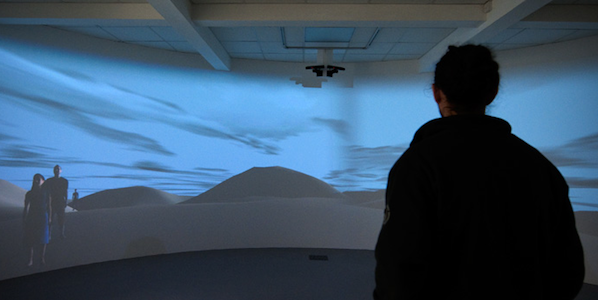
What these works achieve is the proposition of a ‘possible world’ where depersonalisation is understood as part of the virtual, nominal, mapped collective fantasy, which somehow then relates to the changing ‘world view’ of the Western citizen. It is also where the reference to science fiction comes from, ‘Monsters of the Id’ referring to the film Forbidden Planet. Science fiction is perhaps referred to in order to re-conceptualise our thinking as part of this Western view. In this sense it is about empowering us to think differently about the portrayal of conflict itself in the twenty-first century and to understand it as lived experience within specifically managed environments.
This is largely achieved through Cotterrell’s translation of his own experience as war artist in Afghanistan. He seems to want his experience to affect the viewer in a way which is different from that which he witnessed, to a reliance on the imagination instead, provoked by the portrayal of the landscape and militarised environment. Instead the exploration is one of attempting to convey the sense of isolation he felt in the military field hospital.
What becomes apparent on seeing this work, is that we are being presented with data objects, which we are then encouraged to relate to, as though they are the nominal representation of real subjects. It is significant that the work is realised with new technology. All three main works in the show explore a similar landscape but use three different projection systems. In Observer Effect the system relates to interaction with the gallery visitor who influences the installation in spatial relativity, through a device that senses and then calculates, through the algorithms and maths of a game engine, their relationship to the virtual space. Alternatively, in Searchlight 2, there is a synthesis between real and virtual as the figures traverse the landscape. He has said in relation to this piece that ‘from a great distance we lose empathy with the figures crossing the landscape’. In Apparent Horizon, the viewer encounters a semi-immersive relationship with video projected onto specially designed hemi-spheres, a view of the horizon, and a lengthy period of waiting for something to happen, which captures the tension between periods of violence. In this sense the artist has worked both as a war artist and as an artist using and developing the application of new technologies.
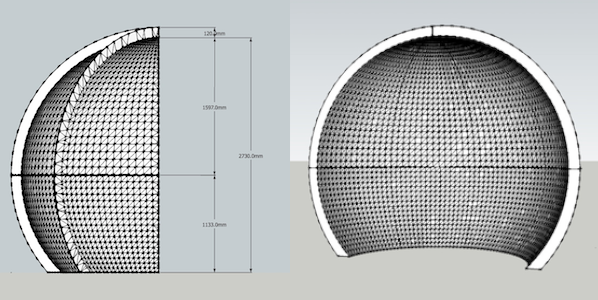
He talked about computer programming having a tendency towards ‘megalomaniac control’, and that the installation was addressed towards ‘how an audience inhabits a gallery’, with no ‘fetishizing of computers’. The residency at SEOS has obviously affected the nature of the technology employed in the work, with two ‘black boxes’ enabling aspects of the projections, as well as the hemi-spheres as immersive hardware. The system of Observer Effect is adaptive and therefore responds to the accumulated impact of viewers in the gallery. He talked about how a commercial games company would find it easy to make, but for him it had been a steep learning curve.
Cotterrell was able to return to Afghanistan in early 2008, due to support from the RSA, and was therefore able to look at the territory of the desert ‘outside the bubble of the military’, which had given him a limited understanding of the environment, a sense of dislocation, and the apprehension of casualties brought from the desert war zone. On this occasion he grew a beard and was able to disguise himself sufficiently so that he could interact with different groups of Afghani people and to gain a ‘pluralism of experience’, as on this occasion he was not part of the chain of command. In this second journey, he was ‘low value’ and therefore able to wander more freely.
Initially, he found it difficult to deliver art work in response to what he had experienced in Afghanistan. He was aware of the historical dilemma of the conflict between medicine and war. But for him, the trauma was ‘quieter’ and involved loss of identity. For example, the twenty-one year old soldier who after severe injury was ambiguous about what would happen for the rest of his life.
He found the operating theatre at the field hospital was ‘like a stage set’, and he took photographs of the surgeons, but found that the documentation ‘didn’t document’ sufficiently his lived experience. At one point he left a video camera running, documenting the arrival of casualties and then, when he was back at home, he edited the footage and left only the moments when attendant individuals ‘allowed their guard to drop’. He questioned though, whether ‘it was right to document trauma’. This left him with the ‘impossibility of conveying content’.
As war artist he has chosen to explore the military and political relationships with the technological portrayal of soldiers and civilians within a territorial combat zone. This is sufficient for Cotterrell in order to convey the sense of isolation and the particular landscape of Afghanistan. In this way, apprehending the virtual or nominal as a way of perceiving what could be real, and is real in a conflict situation, puts the viewer in a complex position, of both suspending disbelief and recognising the construct. The final work Monsters of the Id, includes in a small installation an army tent, desk and military communications equipment. This conjures up an image of Cotterrell’s experience as a war artist, although in fact it is his portrayal of how we might think of it – as naïve in other words.
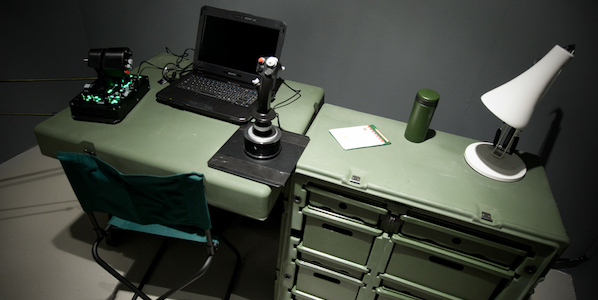
For the team of curators, gallery staff, and the artist, it has been curatorially important to work within the gallery space and Cotterrell claims that the ‘virtual can only really be understood in a gallery context.’ This is enabled through the works being not fully immersive so that you can stand back and reflect. As such the show is all about ‘the manipulation of imagery’ informed by the residencies in Afghanistan and at SEOS.
The exhibition continues till 31 March 2012 at the John Hansard Gallery, Southampton
Italian artist duo Art is Open Source (AOS) will be working as Artists in Residence at Furtherfield Gallery and lab space in February 2011. During the four week residency Salvatore and Oriana will work on the development of their latest project REFF: the invasion of ordinary reality to reinvent a new one using a fake institution, a book, an urban performance and an augmented reality drug.
The residency will result in a final exhibition, REFF – REMIX THE WORLD! REINVENT REALITY!, showcasing a live, glitch performance, an urban intervention and a virtual entity by artists featured in the new REFF book: Garrett Lynch (Ir), Rebar Group (US) and xname (It) alongside a real-time interactive map that describes the life of REFF all over the world: 60 authors, artists, designers, architects, hackers, journalists, activists; dozens of actions; a live and real-time stream of information collectively produced by a worldwide community of re-inventors.
In the three weeks prior to the exhibition opening AOS will run workshops with students to use the augmented reality application. The students’ interventions will form part of the urban performances which will populate the gallery during the 4 week exhibition.
”The use of communication technologies and invasive practices for the reinvention of reality is crucial for student movements in this difficult moment. We would like to get the students involved in the REFF experiments by providing them with access to those technologies that can work as effective forms of critical and alternative communication. Students in UK and in Italy will have access to all the cross-medial CMS used to build the REFF book which will
enable them to create their own QRCodes and Fiducial markers that they can then stick around the city to disseminate information integrated within their communication across the web and the city.” – Art is Open Source
More information about the exhibition and workshops
For more about Art is Open Source and Fake Press:
www.romaeuropa.org
www.fakepress.it
www.artisopensource.net
Events related to this residency:
REFF – REMIX THE WORLD! REINVENT REALITY! at Furtherfield Gallery, 25 February – 26 March 2011.
REFF – REMIX THE WORLD! REINVENT REALITY! Opening Event at Furtherfield Gallery, 25 February 2011, 6:30-9pm
‘Living’ is the result of a six month residency at the V&A by Christian Kerrigan – from January to June 2010 – and it is part of The 200 Year Continuum. The 200 Year Continuum is the title of a project by the same artist that explores the relationship between nature and technology. Interestingly ‘Living’ was exhibited in the same space where it was created: in the digital studio of the V&A. This was a small room with dim light and crowded with rarities. It felt like one was penetrating the secretive and magical space of experimentation of some sort of mad professor.

Once in the space my gaze wandered around a series of oddities. On the right, a table full of raw materials; in the middle of the room, a fish tank with algae floating in high pH waters; on a wall, a real time video projection showing the evolution of the algae; on a different wall, a slide projection showing some drawings; in some shelves, notebooks with notes by the artist; above the sink, chemical products piled up on a shelf; and on each and every window a semi-transparent drawing. No explanations, no titles, nothing. It’s you and the objects. Luckily Christian Kerrigan was always about, meeting visitors and discussing the work. We started looking at the materials on the table. Christian told us those were unprocessed rocks and crystals that he used as the starting point for his drawings. He scanned pieces of amber, moss, fiber glass, volcanic rock or resin and produced a model using 3D software. Then he manipulated that model to create his drawings and printed them on semitransparent paper. He eventually placed them on the windows of the space. This routine allowed him to explore the different stages of a process that makes real matter and virtual space intermingled. It is a practice that explores where the process of creation begins, and what it does to reality. ”The drawings, he tells us, become extensions of the physical material which I started with.” Although we have become accustomed to discuss the hybridity of our nature-culture, the way Christian carefully interwove materialities and virtualities was very evocative. The fact that the drawings were placed on the windows gave yet another layer of complexity to the mixture. The colours of the printings morphed natural light into a hybrid light turning the atmosphere of the room into a creative and ongoing process.
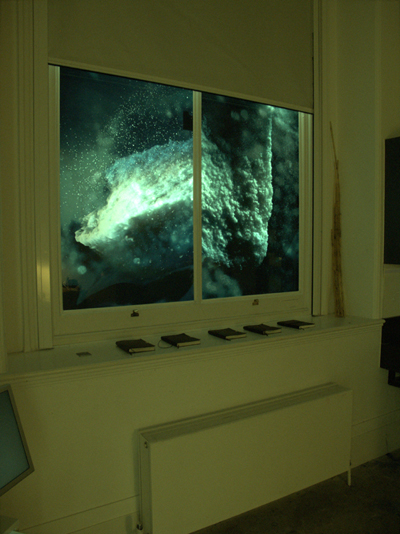
Next I wondered about that mysterious fish tank in the middle of the room where algae lived (and died) in high pH waters: Encased Nature. Apparently the algae reacted to the elevated pH creating a protective coat that eventually killed them. At the bottom of the tank: a graveyard of coated dead algae showed the consequences. I instantly loved the idea. Again an experiment about the hybridity of natural and controlled habitats. I thought it was a particularly dystopic illustration of the environment we inhabit where control works on the conditions of the environment, dictating the way reality unfolds. This is an emerging tendency in our most-discussed societies of control, what has come to be called soft control. And we could take it even further, and see it as a great illustration of today’s climate of fear. In such a habitat, the threat has become virtual and all-pervasive, it has become poisonous in itself, just like high pH. The nightmare of security measures that this artificially produced environment justifies links quite well to the ‘lethal-protective’ coat. What this allegory leaves out, though, is the power of imagination! The capacity of conditions to be turned around, the potential for intervention and deviation from the pre-programmed chain of (re)actions. The idea of projecting a live video recording on the wall was to intensify the experience and highlight the importance of mediation. As Christian argued, we are now more used to experience nature through a lens than to experience its presence. However, the quality of the footage seemed to work against the intentions of the artist and rather than intensifying the experience of that enclosed nature, it tended to obscure it. The particular texture that the webcam gave to the recordings turned that hybrid habitat almost into an abstract movie. On a different corner there was another video projection made out of a series of drawings. Interestingly they had been created using a ‘living technology’ and recorded at a nano-scale. For Living Drawing, the artist had collaborated with Martin Hanczyc from the Department of Physics and Chemistry at the University of Southern Denmark. They had manipulated some protocells that inhabited chemical gradients and reacted to ultraviolet light. When UV light was applied to the fiberglass where these protocells ‘lived’ their motion left traces of colour that were recorded. This technique, although still in its early stages, allowed the artist to ”explore the spontaneous event of drawing by using organic systems”, he told us. Kerrigan’s rather cryptic exhibition proved to be an inspiring and very personal exploration of the blurring between nature and culture in its absolute physicality. Paying particular attention to the materiality of the creative process, from the composition of the materials used, to the chemistry of the drawing process or to the laws of electromagnetism that inform light in its interaction with his work, his methodologies show a passion for unfolding reality in its many scales. His work is that of someone who’s starting to explore rather than someone who’s making an assertion; it is tentative rather than conclusive, it is interesting for its questions rather than its answers. However, even if sometimes vague, it is at points pleasingly dark and sometimes inspiringly intense.
Helen Varley Jamieson and Paula Crutchlow will be working as Artists in Residence at HTTP, Furtherfield’s Gallery and lab space in July 2010. During this residency Helen and Paula will work on their make-shift project.
Events related to this residency:
make-shift presentation by the artists at HTTP Gallery, 22 July 2010.
More information about this work in progress presentation.
“make-shift is an intimate and participatory performance event that explores the fragile connectivity of human and ecological relationships. Part recital, part discursive salon the performance uses online audio-visual conferencing, chat and performance tools to connect two ordinary living-rooms and their audiences across geographical and cultural distance.”
http://make-shift.net/
Helen Varley Jamieson is a writer, theatre practitioner and digital artist from New Zealand. In 2008 she completed a Master of Arts (research) at Queensland University of Technology (Australia) investigating her practice of cyberformance – live performance on the internet – which she has been developing for over a decade. She is a founding member of the globally-dispersed cyberformance troupe Avatar Body Collision, and the project manager of UpStage, an open source web-based platform for cyberformance. Using UpStage, she has co-curated online festivals involving artists and audiences around the world. Helen is also the “web queen” of the Magdalena Project, an international network of women in contemporary theatre.
www.creative-catalyst.com
Paula Crutchlow lives with her family in Exeter, Devon. She graduated in Dance from De Montfort University, and in 2000 completed an MA in Devised Theatre at Dartington College of Arts, UK where she is now an Associate Lecturer in Theatre. Paula has worked in Britain and internationally as a performer, director and tutor of movement and devised theatre. As a co-founder and Artistic Director of Blind Ditch she has collaborated on context-specific collaborative art, performance and cultural events which engage audiences and participants in distinct ways through the use of digital media and live performance.
www.blindditch.org
>> make-shift work in progress presentation by Helen Varley Jamieson and Paula Crutchlow
Thursday 22nd July 7pm
HTTP Gallery
RSVP: brokers@make-shift.net
You are invited to attend and actively contribute to a work in process sharing of make-shift – a networked performance about connectivity and consequences.
Helen Varley Jamieson (NZ/Europe) and Paula Crutchlow (UK) are artists from different performance backgrounds whose new collaboration, make-shift, explores meaningful ways of engaging in discussion across physical and digital networks. make-shift will be a salon-style event, taking place simultaneously in two domestic spaces (with one artist present in each space) and also online.
The process of making make-shift has begun with a two-week residency at Furtherfield.org, London, and in this presentation the artists would like to share some of their research and try out some ideas. You will be asked questions and invited to contribute your expertise, experience and opinions to this process. The artists are working in the spaces between disciplines and genres and are deliberately inviting people from a range fields to get a range of input. Your contribution to this will be very much valued.
You must RSVP (to brokers@make-shift.net) as the proximal audience is limited (there will also be the opportunity to participate online if you are not in London or can’t get to the event). Everyone who is attending is asked to collect their plastic rubbish over a 24 hour period and bring it to the presentation (please wash anything that had food in it!)
We also need two volunteers to prepare specific tasks before the event – please email brokers@make-shift.net if you would like to volunteer.
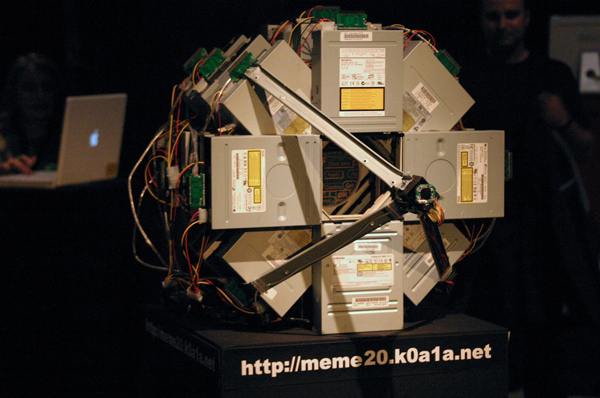
Danja Vasiliev will be working as an Artist in Residence at HTTP, Furtherfield’s Gallery and lab space in March 2010. During this residency Danja will work on his Netless project. Netless is an attempt to create a new network, alternative to the internet. More precisely – networks within existing city infrastructures, possibly interconnected into a larger network alike the internet. Netless is not dependent on specialized data carriers such as cables or regulated radio channels. In fact, there is no permanent connection between all of its hosts (peers) at all – it is net-less.

The network is based on the city transportation grid, where traffic of the vehicles is the data carrier. Borrowing the principals of the ‘sneaker-net’ concept, the information storage devices are physically moved from point A to point B. Numerous nodes of the netless network are attached to city buses and trams. Whenever those vehicles pass by one another a short range wireless communication session is established among the approaching nodes and the data they contain is synchronized. Spreading like a virus, from one node to another, the data is penetrating from the suburbs into the city and backwards, expanding all over the area in the meanwhile. The signal of any of netless nodes can be received and sent to using any wifi enabled device – a laptop, pda or mobile phone.
There are no addresses or routes in the netless network – any participant can potentially receive all data circulating in the network – all data is broadcast. Personal messages and datagrams can be sent using pgp-like personalized keys which ensure that only two people (the original sender and intended receiver) can decipher the message. Only such, as it might seem, oversimplified approach for communication allows the network to be completely homogeneous and flat – any node can be replaced by any other without any modification or configuration. In such an environment it is also impossible to trace data flows.
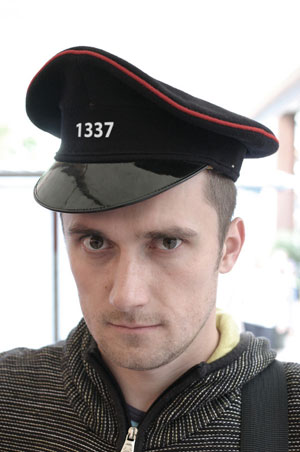
2006-2008: MA in Networked Media (Media Design) at Piet Zwart Institute, Netherlands
2006-2003: BA in ‘Media art’ AKI Academy of Visual Art and Design, Netherlands
2000-2001: Institute ‘ProArte’, short course of new media arts, Saint-Petersburg, Russia
1996-1999: Academy of Culture and Art, Media and Information Design, Saint-Petersburg, Russia
Danja Vasiliev is a co-founder of moddr_lab – http://moddr.net/.
Annie Abrahams will be working as an Artist in Residence at HTTP Gallery in January 2010. During the residency Abrahams will work on the production of three new works including live telematic and online networked performances to be presented as part of If not you not me at HTTP Gallery in February 2010.
Annie Abrahams (b. NL 1954, lives and works FR) is an internationally regarded pioneer of networked performance art. If not you not me at HTTP Gallery in London was the first solo exhibition of her work in the UK. While social networking sites make us think of communication as clean and transparent, Annie Abrahams creates an Internet of feeling – of agitation, collusion, ardour and apprehension.
The residency and exhibition are conceived in connection with Furtherfield’s Rich Networking project interrogating the transparency of communication, artistic collaboration and sociability through digital networks; and as part of Furtherfield’s three-year Media Art Ecologies programme which foregrounds practices sharing an ecological approach – an interest in the interrelation of technological and natural processes: beings and things, individuals and multitudes, matter and patterns.
Working with simple interfaces, disruptions in data-flow and carefully crafted instructions, Abrahams sensitises participants and audiences to glitches in communication and invites them to experience and reflect on different ways of being together in a machine-mediated world. The exhibition asks how we deal with the tensions of collaboration and physical separation as we negotiate relationships through video imagery, computer software and digital networks.
Annie Abrahams was born to a farming family in a rural village in the Netherlands. She obtained a doctorate in biology in 1978 and found that her observations of monkeys inspired curiosity about human interactions. After leaving an academic post, she trained as an artist and moved to France, where she became interested in using computers to construct and document her painting installations. She began experimenting with networked performance and making art for the Internet in the mid 1990s. Her work has since returned to the questions raised by the monkeys, concentrating on the possibilities and limitations of communication on the Internet. She has performed and shown work extensively in France, including at the Pompidou Centre, Paris, and in many international galleries including among others Espai d’Art Contemporani de Castelló, Spain; the Museum of Contemporary Art, Tokyo; and the Armenian Center for Contemporary Experimental Art, Yerevan; festivals such as the Moscow Film Festival and the International Film Festival of Rotterdam, and on online platforms such as Rhizome.org and Turbulence.
Kate Rich will be working as an Artist in Residence at HTTP, Furtherfield’s Gallery and lab space, in Summer 2009. During this residency Kate will develop and work on the first instantiation of the Feral Trade project as working café.
Kate Rich is an Australian-born artist & trader. In the 1990s she moved to California to work as radio engineer with the Bureau of Inverse Technology (BIT), an international agency producing an array of critical information products including economic and ecologic indices, event-triggered webcam networks, and animal operated emergency broadcast devices. The Bureau’s work has been exhibited broadly in academic, scientific and museum contexts. Restless at the turn of the century, she headed further east to take up the post of Bar Manager at the Cube Microplex, Bristol UK where she launched Feral Trade. She is currently moving deeper into the infrastructure of cultural economy, developing protocols to define and manage amenities of hospitality, catering, sports and survival in the cultural realm.
Feral Trade has been based in Bristol since 2003 and is well established among media arts practitioners and organisations, who act as couriers, diners and depots in the network. Kate Rich’s Feral Trade Café at Furtherfield’s HTTP Gallery extends the model more deeply into the economy of the not-for-profit arts. As well as serving Feral Trade goods, the café will provide a local trading station and depot for the Feral Trade network, and present research and discussion around both food provenance and hospitality protocols for artist-run venues. HTTP Gallery will also invite groups from the local Harringay community, as well as local and international artists to contribute their own home-produced food items for sale in the café. Proceeds will support the producers, ongoing development of the project, and HTTP Gallery. Local groups with interest in food, ecology, media and art will also be invited to use the Café as a meeting space.
Feral Trade Café is the first element of Furtherfield’s three-year Media Art Ecologies programme, which aims to provide opportunities for critical debate, exchange and participation in emerging ecological media art practices, and the theoretical, political and social contexts they engage. The project will successively featured at Transmediale Festival, Germany, and the 2010 AV Festival in Tyneside.
Jeremy Bailey will be working as Artist in Residence at HTTP, Furtherfield’s Gallery and lab space, in Summer 2008. As part of the residency HTTP Gallery has commissioned a new satirical performance called Warmail which is the central piece in Bailey’s upcoming HTTP exhibition, The Jeremy Bailey Show in Autumn 2008.
The Jeremy Bailey Show, Bailey’s first solo exhibition in the UK, will present many of Bailey’s most recent works including VideoPaint 3.0 and SOS, alongside the new commission, Warmail, produced during his adjunct residency. This brand new performance work pokes fun at the value placed on “collaboration” in today’s art practice and policy-making. The performance will be staged live at the exhibition opening (Friday 19 September 2008, 7:30pm) and documented for viewing throughout the exhibition. Bailey plans to co-demonstrate, with his audience, new collaborative software that will allow participants to perform office related tasks such as email, word processing, or spreadsheets together while simultaneously composing a visual/musical score with matching choreography.
Jeremy Bailey received his MFA in Video Art from Syracuse University and an undergraduate degree in Visual Studies from the University of Toronto. He is co-founder of award winning artist video collective 640 480. His work has been described by Filmmaker Magazine as “a one man revolution on the way we use video, computers and our bodies to create art”. Bailey lives and works in Toronto, Canada.
Rachel Beth Egenhoefer considers her Commodore 64 Computer and Fischer Price Loom to be defining objects of her childhood. She creates tactile representations of cyclical data structures in candy and knitting and is currently researching the intersection of textiles, technology, and the body.
Events at HTTP >
Other Related Events >
Rachel Beth will be working as an Artist in Residence at HTTP, Furtherfield’s Gallery and lab space in April 2008. She has been brought to UK from San Francisco as part of the Distributed South initiative, which is a network intended to raise awareness of the considerable activity in media arts in South of UK. Through residencies and collaborative events co-curated by SCAN and Space Media, Distributed South seeks to develop and build collaborations and networks in media arts and all are welcome to take part. Egenhoefer’s residency consists of several key parts – experimental studio time to create new work at the University of Brighton, presenting workshops and lectures across the south of England, a commissioned exhibition at Lighthouse Brighton, all culminating with time spent in residence at Furtherfield.
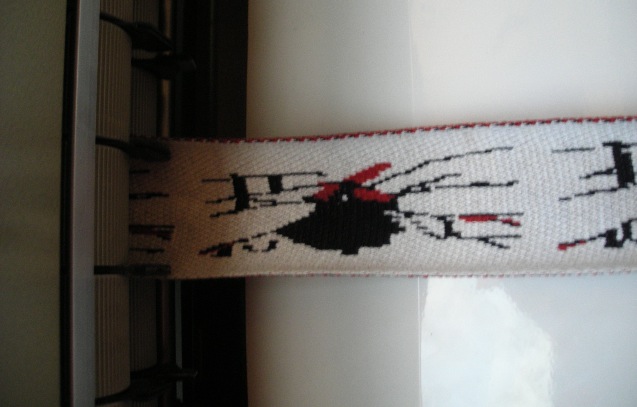
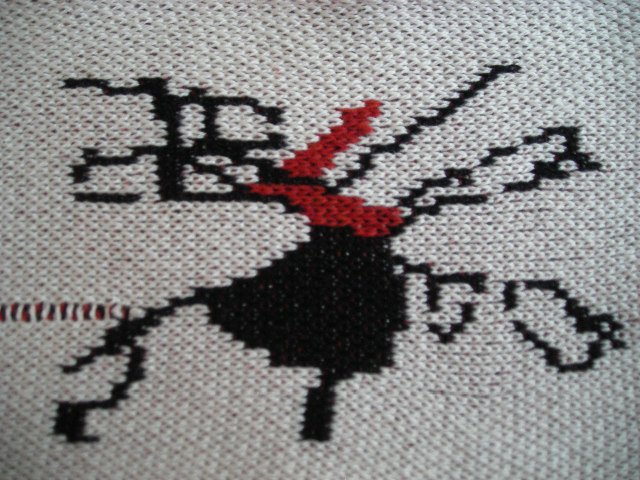
Currently Rachel Beth is working in the studio on ideas comparing tactile knitting to intangible computer code and how the body interacts and moves with both. In addition to building a knit zoetrope, casting the space between body and machine in candy, she has also been tracking the motion of knitting needles in both physical and virtual space and knitting with the Nintendo Wii. Her time at Furtherfield will be used to continue exploring these ideas while interacting with the larger community and audiences Furtherfield brings.
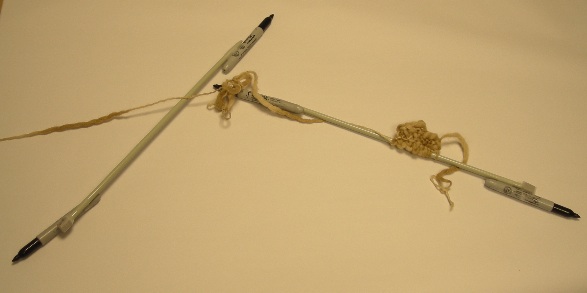
Higher Education Student Day
Wednesday April 15, 1:00-4:00pm
Rachel Beth will present her work and professional practice from the residency to higher education students
This event is free however advanced booking is necessary.
Networking Event and Residency Closing Party
Configurations: Technology and Textiles Networking Afternoon
25 April, 3.30 – 6pm, HTTP Gallery (Booking essential)
You are invited to share ideas, discuss and develop future working around art work that investigates the relationship between new technology, traditional making techniques and transformative political actions. Anna Dumitriu, Ele Carpenter, Nicola Naismith and Rachel Beth Egenhoefer will present their work using diverse approaches to the making of work using new technology alongside textiles, followed by a “Long Table Discussion”.
The “Long Table Discussion” is an experimental public forum developed by performance artist Lois Weaver. It is a hybrid performance, installation and roundtable discussion designed to facilitate informal conversations on serious topics encouraging everyone to contribute. Previous “Long Table Discussions” include conversations on Women and Prisons, Human Rights and Performance and Manufacturing Bodies.
This event is free however advanced booking is necessary. To book places please email Aaron, visibilityATfurtherfieldDOTorg.
Closing Party for Rachel Beth Egenhoefer 6pm – 9pm (all welcome): Party to celebrate the close of Rachel Beth Egenhoefer’s residency at Furtherfield/HTTP Gallery and providing an opportunity to discuss her work and experiences during the residency.
Rachel Beth Egenhoefer’s residency and Configurations is part of Distributed South an initiative co-curated by SCAN and Space Media. The residency and event is funded by the Arts Council England, University of Wales, University of Brighton, Lighthouse Brighton with support from Furtherfield.org, Textile Futures Research Group (TFRG) and University of the Arts London.
71, Ashfield Rd, London N4 1NY
Click here for map and location details
Distributed South www.distributedsouth.org.uk
www.rachelbeth.net
www.elecarpenter.org.uk
www.nicolanaismith.co.uk
www.annadumitriu.co.uk
Candy & Code
Institute of Contemporary Art (ICA) London _Textile Futures Research Group
Monday March 17, 2008, 6:30-8:30pm
Presentations from Rachel Beth Egenhoefer, Barbara Rauch & Nicola Naismith
Following by a panel discussion with the artists and Dr Jane Harris, Director of TFRG, Helen Sloan, Director of SCAN.
Exhibition of New Work
Lighthouse Brighton
March 20- April 5, 2008
Opening Reception: Thursday March 20, 6:00-9:00pm
Talk on Residency and Distributed South (with Rachel Beth Egenhoefer and Helen Sloan) with an opportunity to view the exhibition: Thursday March 27, 7:30pm, doors open at 7
Rachel Beth’s residency for Distributed South is funded by the Arts Council England, University of Wales, University of Brighton, Lighthouse Brighton and supported by SCAN, Space Media, Furtherfield.org, Textile Futures Research Group (TFRG) and University of the Arts London.
Featured image: A database of 50,000 random Internet images.
Richard Wright will be working as Artist in Residence at HTTP, Furtherfield’s Gallery and lab space for one year, from Summer 2007 to Spring 2008. The residency will culminate in a HTTP Gallery exhibition, How To Talk To Images, featuring a retrospective of computer animations and a new online work drawing on a database of 50,000 random Internet images.
Richard Wright has been making digital animation and interactive pieces since the eighties. Heliocentrum, an animation about Louis XIV, was described by writer Hari Kunzru as “…an amazingly effective way of showing how a sovereign manipulated power” and The Bank of Time was nominated for a BAFTA in 2001. Richard was most recently a member of artists group Mongrel and is currently working on an urban media project called “decorative surveillance”.
For How to Talk to Images, Richard Wright plans to compile a database of 50,000 random Internet images as the raw content for two artworks. The Internet Speaks and The Mimeticon both explore new conceptions of the image, called for by the sheer quantity of visual information now available via the Internet. The exhibition will also be the occasion of limited-edition poster featuring an essay by the artist illustrated by the entire visual history of the Western alphabet – from its pictorial Egyptian origins 5,000 years ago to its perfected form under the Romans, as well as a new monograph documenting the artists twenty year long practice.
American ‘girl gamer’ artist and theorist, Mary Flanagan will be working as Artist in Residence at HTTP, Furtherfield’s Gallery and lab space in Spring 2006. As part of the residency HTTP Gallery has commissioned [giantJoystick] for the Game/Play exhibition, a national touring exhibition, in collaboration with Q-Arts (now Quad), Derby, which explores goal-orientated gaming and playful interaction in media arts practice.
[giantJoystick] offers a humorous reworking of the multi-player game. Visitors are invited to collectively play classic arcade games with a nine foot tall joystick modelled after the Atari 2600 one. The competitive goals of these classic arcade games are already familiar, however the dramatic change in scale of the joystick necessitates both an encounter of the whole body with the artwork and cooperation between a number of players in order to reach them.
Mary Flanagan is an artist, author, educator, and designer. Known for her theories on playculture, activist design, and critical play, Flanagan has achieved international acclaim for her novel interdisciplinary work, her commitment to a theory/practice dialogue, and contributions to social justice design arenas. Her research examines the boundaries between the personal and the public, perception, power, and what technology can teach people about themselves. Using the formal language of the computer program or game to create systems which interrogate seemingly mundane experiences such as writing email, using search engines, playing video games, or saving data to the hard drive, Flanagan reworks these activities to blur the line between the social uses of technology, and what these activities tell us about the technology user themselves. Her artwork ranges from game based systems to computer viruses, embodied interfaces to interactive texts; these works are exhibited internationally at venues including the Laboral Art Center, Whitney, SIGGRAPH, Beall Center, The Banff Centre, The Moving Image Center, Steirischer Herbst, Ars Electronica, Artist’s Space, Guggenheim, Incheon Digital Arts Festival, and and venues in Brazil, France, UK, Canada, Taiwan, New Zealand, and Australia.